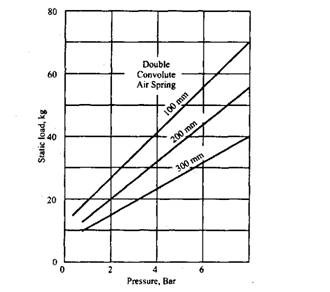22.8.
Spring Characteristics.
The bounce frequency of an air spring decreases or increases as the sprung weight increases or decreases respectively. This factor plays a vital role in the quality of ride, which can be easily noticed on a heavy goods or passenger vehicle where the variation of a fully laden to unladen weight ratio can be up to 5 :1.
An inherent disadvantage of leaf, coil and solid rubber springs is that the bounce frequency of vibration increases considerably as the sprung spring mass is reduced (Fig. 22.40). If a heavy goods vehicle is designed for a best ride frequency of say 60 cycles per minute when fully laden, then as this load is removed, the suspension’s bounce frequency could rise approximately to 300 cycles per minute if steel or solid rubber springs are used, so that a very harsh, uncomfortable ride is experienced. Air springs, on the other hand, can operate over a very narrow bounce frequency range (of around 60 to 110 cycles per minute for rolling lobe air spring) for considerable changes in vehicle laden weight. Therefore, the quality of ride with air springs is uniform over a wide range of operating conditions.

Fig. 22.40. Effects and comparison of payload on spring frequency for various types of spring media.
Steel springs have a constant stiffness and so their vertical deflection varies directly with the increase of spring mass. On the other hand air springs have rising spring stiffness with increasing load because of the enlarging of their effective working area as the spring deflects (Fig. 22.41). This stiffening characteristic matches well with the increased resistance required to counteract the spring deflection as it approaches the maximum bump position.

Fig. 22.41. Effects of static load on spring height.
The spring mass at constant spring height is supported and maintained by increasing the internal spring air pressure directly with any rise in laden weight. These characteristics are illustrated in Fig. 22.42 for three different set optimum spring heights.

Fig. 22.42. Effects of static payload on spring air pressure for various spring static heights.
The spring vibrating frequency is varied by changing the total volume of air in both extra tank and spring bag (Fig. 22.43). The extra air tank capacity is decided on basis of the optimum ride frequency for the vehicle when operating between the unladen and fully laden conditions.

Fig. 22.43. Relationship of extra air tank volume and spring frequency.
